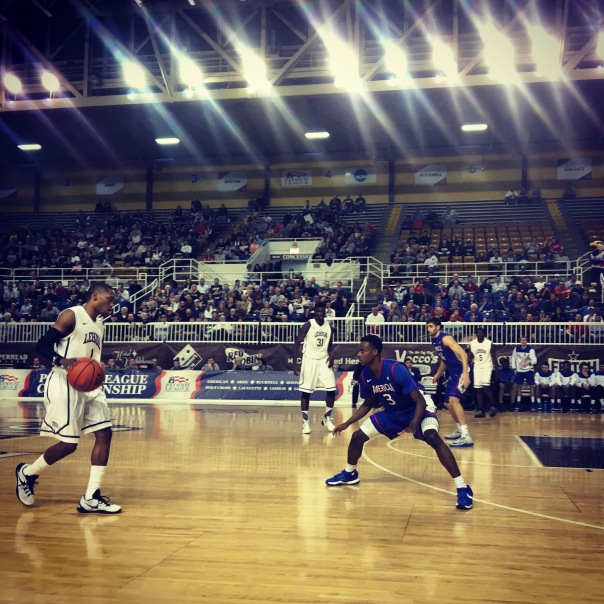
THE NUMBERS
Minutes
MPG: 25.3
% Minutes: 62.6
Offense
Points: 6.4ppg
O-rating: 78.8
E-FG: 41.9%
Two-point shooting: 41.3%
3-point shooting: 28.3%
FT shooting: 64.7%
Assist rate: 10.2% (1.1 apg)
Turnover rate: 20.8%
Defense
Rebounding: 1.7 rpg
Defensive reb %: 7.8%
———————–
STRENGTHS
To properly critique Washington’s season, it’s important to start with this simple fact: The freshman was playing out of position in an offensive system that’s the most difficult to run in college basketball. We said it all season long on the podcast as it was clear in November when his first two games resulted in 0 assists and five turnovers — Washington isn’t a point guard. He plays better off the ball on the wing, which not coincidentally was his best shooting spot on the floor (I wish we had data on his 3-point wing shooting off the catch, because it surely was much better than his overall 28.3% shooting from deep).
Washington was asked to come in as a freshman from California and at least initiate the offense of a team that lost its two most important players from the season before. The task was unfair from the beginning, and the expectations were probably too high. So when assessing Washington’s strengths, it’s important to view him as a wing player as opposed to a point guard.
Most importantly and as a harbinger of things to come, Washington didn’t back down against American’s top opponents. He played his best game — which not coincidentally was also the Eagles’ peak performance — in AU’s 69-55 victory over first-place Bucknell in early February. Washington also gave AU a huge spark during an impressive first half at LSU (9 pts, 4-5 FGs), and had 11 points at VCU. I’m not giving him the “Big Game James” moniker just yet, but Washington isn’t one to cower against the heavyweights.
Additionally, while Washington’s assist/turnover numbers are atrocious for the season (1.1/1.6 per game), a closer look demonstrates the progress he made at valuing the basketball and seeing the court better during February.
James Washington ball control by month:
November
Minutes played: 125 (25 mpg)
Assists: 3
Turnovers: 8
1 turnover every 15.6 minutes
December
Minutes played: 198 (28.2 mpg)
Assists: 13
Turnovers: 17
1 turnover every 11.6 minutes
January
Minutes played: 210 (26.25 mpg)
Assists: 6
Turnovers: 8
1 turnover every 26.25 minutes
February
Minutes played: 225 (25 mpg)
Assists: 11
Turnovers: 12
1 turnover every 18.75 minutes
As the season progressed, Washington played more and more off the ball. His usage rate decreased, as did — with a few exceptions, such as his four turnovers in 15 minutes vs. Navy Feb. 24 — his miscues. It’s not entirely fair to harshly judge Washington’s poor shooting numbers because so many of his shots came in late-shot-clock desperation situations.
———————–
ROOM FOR IMPROVEMENT
Washington can obviously improve in many ways, but perhaps the area that will most determine his playing time as a sophomore on a team that’ll feature highly regarded freshman Sa’eed Nelson is defense. Throughout the season, it wasn’t hard to locate Mike Brennan yelling not-so-nice things in Washington’s direction after another lost switch or failure to get back on transition defense.
The good news for Washington is that this area is, more than anything, about effort. All one needs to do to see his potential on this end is re-watch the Bucknell win when in 38 minutes, Washington was terrific at getting back defensively every possession against the Bison’s fast-break attack led by speedy Stephen Brown. Washington was locked in all game, and this is the focus he’ll need to bring to the defensive end of the floor in 2016-17.
The other big area is shooting, where Washington will need to greatly improve his 28.3% from 3-point range to be an effective wing player — which he’ll play most often with Nelson in the game — next year. Washington’s 78.4 offensive rating was 57th among Patriot League players, the worst of anyone using the 19.4 possessions per game (or more) he used; his 41.9% e-FG was 37th out of 38 players who played at least 60% of available minutes; and his 41.3% two-point shooting was 49th out of 55 players who played at least 40% of possible minutes and attempted at least two shots per game.
1) Better consistent focus on defense; 2) Improved shooting; 3) Better ballhandling.
———————–
GRADE: C+
———————–
QUOTABLE
“It’s not just one (area of improvement) — just playing, just college basketball’s hard and it’s a lot for a freshman. He’s playing 30 something minutes, the guy’s playing a lot of minutes as a freshman handling the ball, guarding guys, it’s a lot of work.”
— Mike Brennan, Feb. 3
———————–
QUICK TAKE
It was a difficult season for Washington on a team that struggled mightily into late January. At times, the freshman didn’t look like a Division I player. However, then there were the sparks he showed, such as the 19-point outburst at New Hampshire, the first half against LSU, and the entire Bucknell game. Would you rather have a player who never really does anything? Or a player who occasionally shows great potential despite many struggles? The answer is easy — the latter. It’s hard to predict Washington’s sophomore season, but being in a new role will benefit him. How much off guard vs. point he plays will depend on the progression of Nelson, but overall expect a more mature, better-shooting and better defender on the court for the Eagles next November.
Despite his and the team’s struggles, Washington kept his body language relatively positive throughout the trying season — a positive sign, above all else, as he heads into a sophomore year where he could make a big jump on a team stacked with potential.